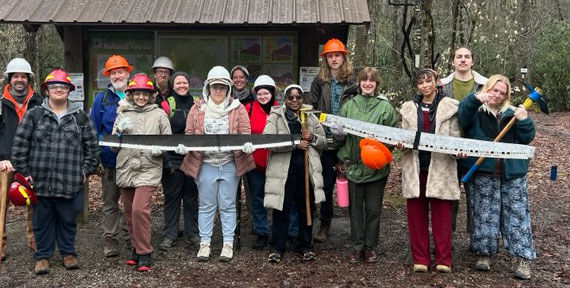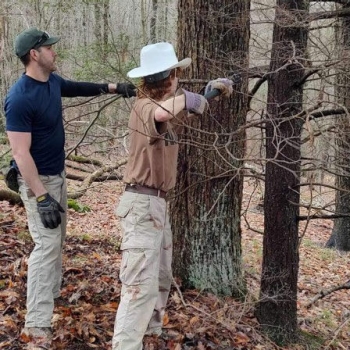‘Restoring Appalachia’ trip follows a new path

By Aysha A. Bodenhamer, Ph.D.
Sustainability Manager
More than a decade ago, Restoring Appalachia – an alternative spring break trip – was created by then-faculty members Richard Roth and Theresa Burriss. It offers Radford students volunteer opportunities to plant trees on formerly strip-mined coalfields in central Appalachia in association with Green Forests Work (GFW), a nonprofit tree-planting organization that helps plant about 400,000 trees a year.
This year’s Restoring Appalachia spring break trip was planned by Aysha Bodenhamer, sustainability manager and associate professor of sociology, with help from Brock Cutler, associate professor of history; Paul Thomas, professor of religious studies; and Matthew Close, professor of biology.
The group was startled to learn that floods in Kentucky had eroded the planned site to the point of being too dangerous to plant, so GFW canceled this year’s project. Having just regained momentum last year following COVID-19, the Radford group leaders searched for alternatives so the trip would not be lost. With Cutler’s help, the group secured a last-minute partnership with Southern Appalachian Wilderness Stewards to plan trail maintenance on the Appalachian Trail.

Students stayed at Radford University’s Selu Conservancy and participated in a team-building exercise conducted by RUABLE, planned and hosted by Nicole Sathre, adjunct professor of Recreation, Parks and Tourism, and her team of interns. This was a great way for students to get to know each other while also building their communication, leadership and problem-solving skills. Students also toured the observatory with Sandra Liss, assistant professor of physics; they learned about the university’s telescope, nicknamed “Geoffrey,” and opportunities to engage in research in astronomy.
Additionally, students had the opportunity to learn from John Bowles, who donated 185 acres of his ancestral land to Radford University in 1989 to create the Selu Conservancy. Bowles educated the students about the property, his ancestors and the Cherokee symbolism throughout the conservancy.
On Saturday, March 2, students packed their lunches and laced up their boots for an all-day adventure, clearing and maintaining parts of the Mount Rogers section of the Appalachian Trail. Volunteers included 11 Radford University students, five professors and staff and other partners from the U.S. Forest Service, Appalachian Trail Conservancy, and Southern Appalachian Wilderness Stewards.
Students learned about Mount Rogers, the highest peak in Virginia; the Appalachian Trail; and George Washington and Jefferson National Forests. Volunteers conducted maintenance on roughly 10 miles of the Appalachian Trail. Some volunteers cleared trails of washouts and fallen trees with two-person crosscut saws, axes and mattocks, while others stained shelters for backpackers. This “spring cleaning” was in preparation to make thru-hikers’ treks safer and easier.
The next day, March 3, volunteers wrapped up with a trip to Mountain Lake to maintain trails and conduct a “solitude study” on War Spur Trail.